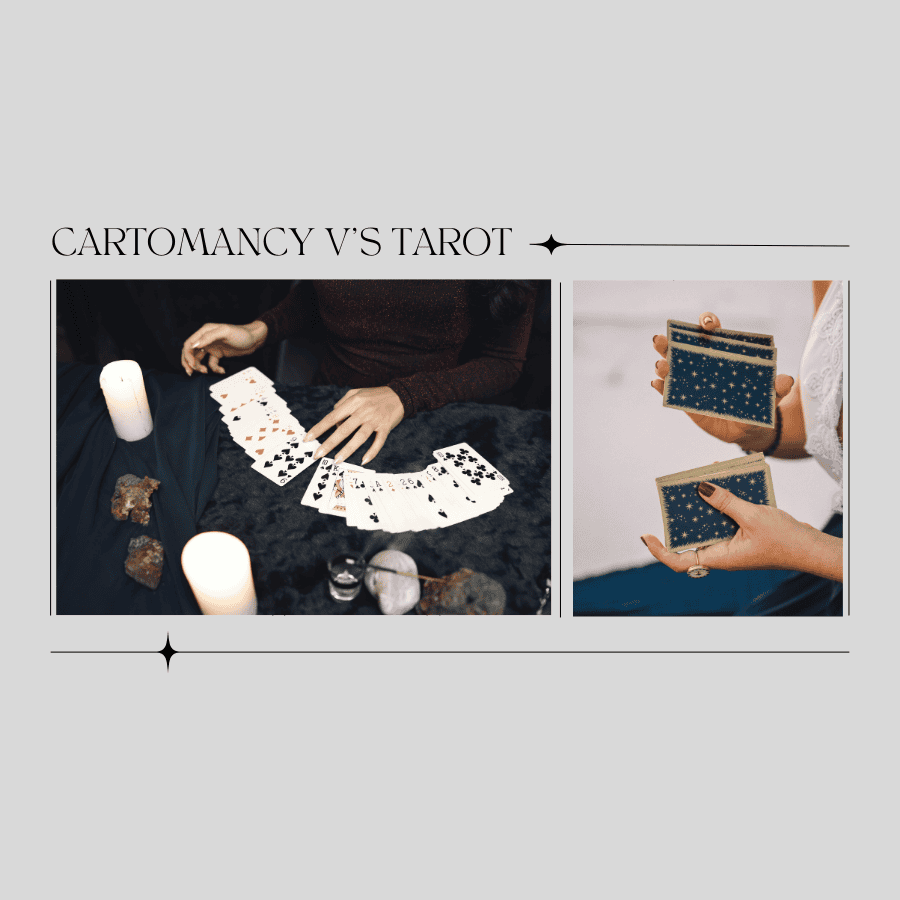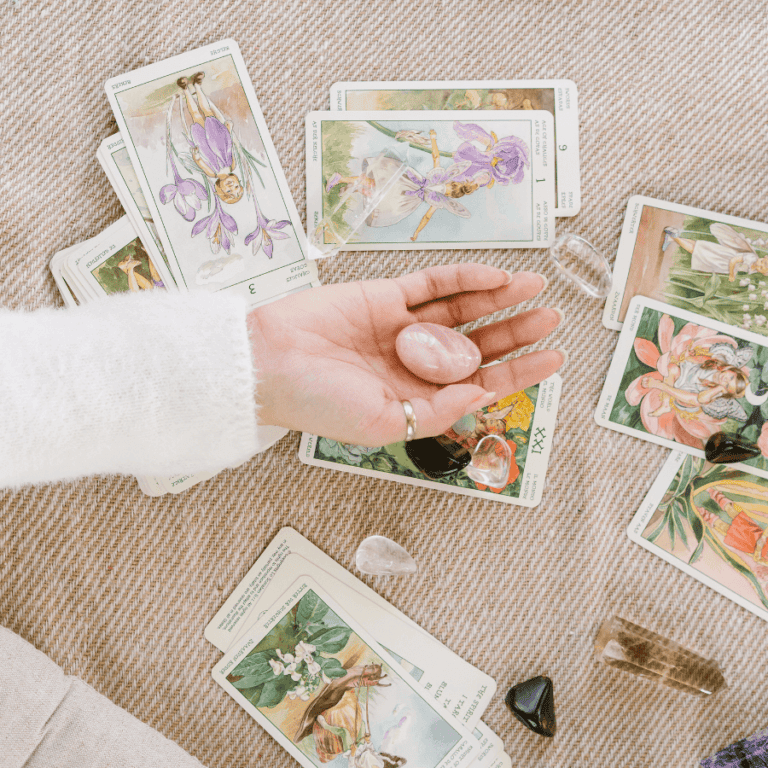Tarot vs Cartomancy
Have you ever wondered how you can discover what your future holds or sought guidance on a current situation?
Throughout history, humans have looked to various tools and practices to find answers beyond what we currently know. One fascinating method of divination that has captured the imagination for centuries is the use of cards. Within card-based divination, two terms often come up: Tarot and Cartomancy. But what exactly is the difference between them?
While both use cards to gain insights, they also both offer different approaches and experiences. This blog post will delve into the world of Tarot and Cartomancy, unpacking their unique characteristics and helping you decide which path might be right for you.
What is Cartomancy?
Cartomancy is the art of divination using a deck of playing cards. Its origins can be traced back to Europe as early as the 14th century, shortly after playing cards themselves were introduced. Back then, cartomancy readings were a popular pastime for both nobility and commoners. Street vendors, known as cartomancers, would offer their services to passersby, using the cards to provide glimpses into love, career, and other aspects of life.
Unlike Tarot, cartomancy relies on a standard deck of playing cards, although some practitioners might use variations like a stripped Piquet deck (removing low cards). The interpretation of the cards in cartomancy focuses heavily on the suit (hearts, diamonds, clubs, spades) and the face value (Ace, King, Queen, Jack, numbers). Each card carries specific meanings associated with love, work, finances, health, and more. For instance, the Ace of Spades might represent bad luck or unexpected challenges, while the Queen of Hearts could symbolize love, compassion, or a helpful female figure.
To conduct a cartomancy reading, the cards are shuffled and then laid out in a specific pattern called a “spread.” The cartomancer interprets the meaning of each card based on its position within the spread and its relation to the surrounding cards. This allows them to weave a narrative and offer insights into the querent’s (the person seeking the reading) situation or answer their questions about the future.
Basics of Cartomancy
Here’s a quick guide to unlocking the symbolic language of each suit in a standard deck of cards:
- Suit of Spades: The Edge of Communication – Just like the swords in the Tarot, spades represent clear communication and the challenges that can arise when expressing ourselves. They can symbolize cutting through confusion or facing obstacles head-on.
- Suit of Hearts: Where Love Makes Its Home – Mirroring the cups suit in Tarot, hearts delve into emotions, family, and the foundation of our relationships. They remind us of the importance of love, compassion, and the connections that nurture us.
- Suit of Clubs: Embracing the Winds of Change – Similar to the wands suit in Tarot, clubs represent swift action and the winds of change that propel us forward. They encourage us to take initiative, embrace new beginnings, and move with agility.
- Suit of Diamonds: Building a Secure Foundation – Just like the disks or pentacles suit in Tarot, diamonds focus on material security, confidence, and financial well-being. They remind us of the importance of building a solid foundation and using our resources wisely.
- The Joker: The Wild Card of Fate – Unlike the structured suits, the Joker exists outside the system, much like the Fool card in Tarot. It embodies the concept of folly, reminding us not to take ourselves too seriously. However, this wild card also signifies unexpected beginnings and the potential for a fresh start. In some readings, the Joker can even represent the querent (the person receiving the reading), highlighting their unique perspective and unpredictable nature.
What is Tarot?
Tarot uses a deck of 78 tarot cards that are filled with rich symbolism and deeper esoteric meaning. While the exact origins of Tarot remain shrouded in some mystery, its historical roots are believed to lie in 14th – 15th century Italy, potentially linked to earlier games and esoteric traditions.
Unlike a standard deck, a Tarot deck is divided into two major sections: the Major Arcana and the Minor Arcana. The Major Arcana, consisting of 22 cards, depicts archetypal journeys, significant life events, and universal themes like The Fool, The Lovers, Death, and The World. Each Major Arcana card carries a potent and multifaceted symbolic language, often portrayed through evocative imagery.
The Minor Arcana, on the other hand, is comprised of 56 cards further divided into four suits: Wands (associated with fire and passion), Cups (water and emotions), Swords (air and intellect), and Pentacles (earth and material world). Similar to a standard deck, these suits contain numbered cards (Ace through Ten) and court cards (King, Queen, knight, and Page). However, the imagery and interpretations within Tarot delve deeper, drawing connections between numerology, astrology, and mythological symbolism.
While cartomancy readings often focus on straightforward answers and practical advice, Tarot readings tend to explore a broader spectrum. A tarot reader might use the cards not only to provide insights into future possibilities but also to illuminate underlying patterns, suggest potential areas of growth, and encourage self-discovery. The emphasis is often placed on the reader’s intuition and their ability to interpret the complex tapestry of symbols woven by the cards in a spread.
Key Differences Between Tarot and Cartomancy
While both cartomancy and tarot offer methods of divination using cards, some key distinctions set them apart:
1. Number of Cards
Cartomancy sticks to the familiar 52-card deck of playing cards, making it readily accessible. You don’t need to invest in a specialized deck or learn a new system. Tarot, however, expands on this format with a unique 78-card deck. This introduces the Major Arcana, a set of 22 cards depicting archetypal journeys and significant life themes. While the Minor Arcana in Tarot shares some similarities with playing cards (suits and numbered cards), the imagery and interpretations are more intricate. This additional layer of complexity in the Major Arcana and the deeper symbolism within the Minor Arcana contribute to the richer experience offered by Tarot readings.
Cartomancy: Relies on a standard deck of playing cards (typically 52 cards).
Tarot: Utilizes a specialized deck of 78 cards, with the Major Arcana (22 cards) adding a layer of complexity.
2. Complexity
Cartomancy interpretations rely primarily on each card’s suit (hearts, diamonds, etc.) and face value (Ace, King, etc.). These associations are relatively straightforward and easier to grasp. Tarot, however, dives much deeper. Each card in a Tarot deck is a richly symbolic image, often depicting complex scenes or figures. Understanding these symbols requires delving into numerology, astrology, and even mythological references. The interpretations are multifaceted and can vary depending on the position of the card within a spread and its relationship to the other cards. This complexity adds depth to a tarot reading but also requires more study and practice so that the reader can interpret the messages conveyed by the cards effectively.
Cartomancy: Interpretations are often more concise and direct, focusing on suit and face value.
Tarot: Symbolism is richer and more multifaceted, takes a bit longer to learn and requires deeper study and intuition for interpretation.
3. Focus
Cartomancy readings often function like a quick snapshot. They directly answer specific questions or offer guidance on immediate concerns, like upcoming events or decisions. Tarot, on the other hand, takes a broader view. While it may offer glimpses into the future, its true strength lies in uncovering underlying patterns, exploring the potential for personal growth, and prompting self-reflection. The focus is less on providing definitive answers and more on illuminating a path for self-discovery.
Cartomancy: Tends to provide practical answers and guidance for immediate situations.
Tarot: Explores deeper themes, potential for growth, and self-discovery alongside future possibilities.
4. Learning Curve:
Cartomancy offers a gentler entry point. The familiar suits and numbers of playing cards make it easier to grasp basic interpretations. In contrast, Tarot demands a deeper dive. Understanding the symbolism woven into the Major Arcana and the nuanced meanings within the Minor Arcana takes time and dedication.
Cartomancy: Easier to pick up due to simpler card meanings and familiarity with playing cards.
Tarot: Requires more dedication to learn the symbolism and interpretations of the Major and Minor Arcana.
Choosing Between Tarot and Cartomancy
Now that you understand the key differences between Tarot and Cartomancy, you might be wondering: which one is right for me? The answer truly depends on your individual goals and preferences. Here are some factors to consider:
1. Your Goals
Consider if you seek quick answers for present concerns (cartomancy) or a deeper exploration of self and potential (Tarot).
Seeking quick answers and practical guidance for immediate situations? Cartomancy might be a good fit. Its straightforward interpretations can provide a helpful nudge for navigating current challenges.
Interested in exploring deeper themes, potential for personal growth, and self-discovery? Tarot delves into these areas, offering insights beyond just future possibilities.
2. Accessibility
Cartomancy’s familiar cards make it easier to pick up, while Tarot requires dedication to learn its unique symbolism.
Both cartomancy and Tarot can be learned, but cartomancy has a lower barrier to entry. The familiarity of playing cards makes it easier to grasp basic interpretations.
Tarot requires more dedication. Understanding the symbolism and interpretations of the Major and Minor Arcana takes time and effort. However, there are many resources available to guide you on your journey.
3. Personal Preference:
Do you enjoy artistic imagery and symbolism (Tarot) or prefer the simplicity of playing cards (Cartomancy)?
Do you enjoy the artistic imagery and rich symbolism found in Tarot cards? The evocative artwork can spark your intuition and draw you deeper into the reading.
Do you feel a connection to the traditional suits and simplicity of playing cards? Cartomancy might resonate more with you if you prefer a more straightforward approach.
Ultimately, the best way to choose is to experiment! Try a cartomancy reading to see if you connect with the method. If you’re drawn to the deeper exploration offered by Tarot, dive into learning the cards and their meanings. Remember, there’s no right or wrong answer. Both Tarot and Cartomancy are valuable tools for gaining insights and navigating life’s journey.
Debunking Misconceptions
While exploring cartomancy and Tarot, you might encounter some misconceptions. Here’s a quick clarification:
- Fortune Telling vs. Self-Reflection Tool: Neither Cartomancy nor Tarot are crystal balls revealing an absolute future. They function more as mirrors reflecting your current situation, potential influences, and inner guidance. The cards empower you to make informed choices and navigate challenges with greater awareness.
- Fright Factor: Cartomancy and Tarot are not about predicting doom and gloom. While some cards might represent challenges, they can also serve as warnings to prepare or encourage course correction. Ultimately, the focus is on personal growth and navigating life’s journey with greater understanding.
The world of divination through cards offers a fascinating way to gain insights and perspectives on life’s journey. Whether you’re drawn to the familiar simplicity of cartomancy or captivated by the rich symbolism of Tarot, both methods can be valuable tools for self-discovery and navigating your path.
This exploration has hopefully shed light on the key differences between Tarot and Cartomancy. Remember, there are other forms of card divination waiting to be explored, such as oracle decks and Lenormand. The most important factor is to find the method that resonates most with you.
Ready to embark on your own card-based divination journey? There’s a wealth of resources available online and in bookstores to guide you. So, shuffle the deck, embrace your intuition, and see what insights the cards have to offer!



